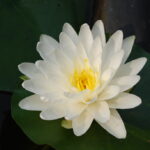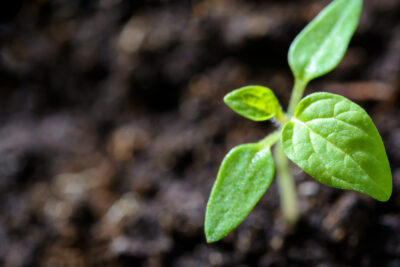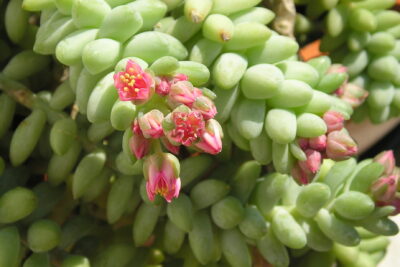
Succulents: Annuals or Perennials in Their Natural Habitat?

Succulents are a diverse group of plants known for their ability to store water in their leaves, stems, or roots. They have become increasingly popular in recent years due to their unique and attractive appearance, as well as their reputation for being low-maintenance houseplants. However, there is often confusion about whether succulents are annuals or perennials in their natural habitat.
We will explore the natural habitat of succulents and their life cycle patterns to determine whether they are annuals or perennials. We will discuss the environmental conditions that favor the growth of succulents, the factors that influence their life span, and the various strategies they employ to survive in harsh environments. Additionally, we will highlight some popular succulent species and their specific life cycle patterns, shedding light on the different ways these plants adapt and thrive in their native habitats.
- Succulents are perennials in their natural habitat
- They have adapted to survive in arid and dry environments
- Their ability to store water in their leaves and stems allows them to withstand long periods of drought
- This adaptation also helps them survive in harsh temperatures and climates
- Succulents have a slow growth rate, which is characteristic of perennials
- They can live for many years, often outliving other plant species in their habitat
- Some succulents even have the ability to reproduce through offshoots or seeds, ensuring their long-term survival
- However, it's important to note that not all succulents are perennials, as some species are annuals in certain regions or under specific conditions
- In cultivation, succulents can be treated as either annuals or perennials, depending on the desired outcome and the specific needs of the plant
- Overall, succulents are primarily perennials in their natural habitat, with their unique adaptations allowing them to thrive in challenging environments
- Frequently Asked Questions
Succulents are perennials in their natural habitat
When it comes to succulents, one might wonder whether they are annuals or perennials in their natural habitat. The answer to this question lies in understanding the unique characteristics and adaptations of these fascinating plants.
Succulents are known for their ability to store water in their leaves, stems, and roots, allowing them to survive in arid and dry environments. This adaptation is what gives succulents their distinct plump and fleshy appearance.
In their natural habitat, succulents are predominantly found in regions with hot and dry climates, such as deserts and semi-deserts. These harsh environments pose significant challenges for plant survival, with limited water availability and extreme temperatures.
Unlike annual plants that complete their lifecycle within a year, succulents are perennials, meaning they have the ability to live for multiple years. This longevity is essential for their survival in their natural habitat, where the conditions are unfavorable and unpredictable.
 Low-Maintenance Plants with Succulent-Like Care and Appearance
Low-Maintenance Plants with Succulent-Like Care and AppearanceSucculents have various strategies to ensure their long-term survival. One such strategy is their slow growth rate, which allows them to conserve energy and resources. By growing slowly, succulents can allocate their limited resources efficiently and sustain themselves for extended periods.
Another remarkable characteristic of succulents is their ability to reproduce through various methods. Some succulents reproduce by producing offsets, also known as "pups," which are small plants that grow from the base of the mother plant. These offsets can eventually grow into fully mature plants, ensuring the perpetuation of the species.
In addition to offsets, succulents can also reproduce through seeds. However, seed germination in succulents can be challenging due to the specific conditions required for successful growth. The seeds often require a period of dormancy followed by specific temperature and moisture conditions to sprout.
Overall, succulents are undoubtedly perennials in their natural habitat. Their ability to store water, slow growth rate, and various reproductive strategies enable them to survive and thrive in harsh and arid environments. So, the next time you admire a succulent, remember that it is a resilient perennial, perfectly suited for its unique habitat.
They have adapted to survive in arid and dry environments
Succulents, with their fleshy leaves and ability to store water, have evolved to thrive in arid and dry environments. These remarkable plants have developed unique adaptations that allow them to survive in conditions where other plants would struggle.
One of the key characteristics of succulents is their ability to retain water in their leaves, stems, or roots. This adaptation is known as succulence and is what gives these plants their signature plump appearance. The thick, fleshy leaves of succulents act as natural reservoirs, storing water for extended periods of time. This ingenious mechanism allows them to withstand prolonged periods of drought, as they can rely on their internal water reserves.
 Discover Fred Ives' Top Recommended Succulent Varieties for Your Home
Discover Fred Ives' Top Recommended Succulent Varieties for Your HomeFurthermore, succulents have developed specialized root systems that enable them to absorb water efficiently. Some succulents have shallow, widespread roots that can quickly take up moisture after rainfall. Others have deep taproots that can reach groundwater sources, ensuring their survival during dry spells. These adaptations enable succulents to make the most of the limited water available in their natural habitats.
In addition to their water-saving abilities, succulents also possess unique anatomical features that help them cope with their arid environments. Many succulents have a waxy coating on their leaves, known as a cuticle, which helps reduce water loss through evaporation. This protective layer acts as a barrier, preventing excessive dehydration and ensuring the plant's survival in dry conditions.
Succulents also employ another clever strategy to reduce water loss – they have the ability to close their stomata, tiny openings on the surface of their leaves, during hot and dry periods. By closing their stomata, succulents can limit the amount of water vapor that escapes through transpiration, further conserving their precious water reserves.
Overall, these adaptations make succulents well-suited to their natural habitats, allowing them to thrive in arid and dry environments. Their ability to store water, absorb moisture efficiently, and reduce water loss through anatomical features demonstrates their resilience and ability to survive in challenging conditions.
Their ability to store water in their leaves and stems allows them to withstand long periods of drought
Succulents have evolved to survive in arid regions by developing a unique adaptation - the ability to store water in their leaves and stems. This characteristic not only gives them their distinctive appearance but also enables them to endure long periods of drought without withering away.
Unlike most plants, succulents have a specialized tissue in their leaves and stems called the parenchyma tissue. This tissue is composed of cells that can absorb and retain water, allowing the succulent to store a significant amount of moisture for future use. By doing so, succulents have become masters of water conservation, thriving in environments where other plants struggle to survive.
 Discover the Perfect Sedum Variety for a Vibrant Blue Succulent
Discover the Perfect Sedum Variety for a Vibrant Blue SucculentWhen the rains are scarce and water becomes scarce, succulents have a remarkable ability to sustain themselves. They can draw upon the stored water within their tissues, utilizing it to meet their metabolic needs and survive prolonged periods of drought. This makes them well-suited to thrive in their natural habitats, where water availability is often limited and unpredictable.
The adaptation of water storage in succulents is not limited to just one plant species. In fact, there are numerous types of succulents, each with their own unique way of storing and utilizing water. Some succulents, like the Aloe vera, store water primarily in their fleshy leaves, while others, such as the Agave, accumulate moisture in their thick stems. The diversity in their water storage mechanisms demonstrates the versatility of succulents and their ability to adapt to various environmental conditions.
It is important to note that while succulents have evolved to survive in arid regions, they are not solely restricted to these habitats. Many succulents can thrive in a range of climates and environments, including tropical regions and even colder climates with proper care. This adaptability has made succulents a popular choice for gardening enthusiasts worldwide, as they can bring a touch of beauty and resilience to any landscape or indoor space.
Succulents' ability to store water in their leaves and stems is a remarkable adaptation that allows them to withstand long periods of drought in their natural habitats. Their unique water conservation mechanisms have played a crucial role in their survival and success as plants, making them a fascinating subject of study and a beloved addition to gardens and homes alike.
This adaptation also helps them survive in harsh temperatures and climates
Succulents, with their unique ability to store water in their leaves and stems, have evolved to be well-suited for survival in extreme conditions. This adaptation allows them to thrive in harsh temperatures and climates that would be challenging for other plants.
One of the main reasons succulents are able to survive in such environments is their ability to retain water. Their fleshy leaves and stems are specifically designed to store large amounts of water. This water storage not only helps the plants endure droughts and extended periods without rain, but it also enables them to survive in regions with limited access to water sources.
 Discover the tallest succulent tree species for your garden
Discover the tallest succulent tree species for your gardenMoreover, succulents have developed other strategies to cope with extreme temperatures. Some species have a waxy or hairy coating on their leaves, which helps reduce water loss through evaporation. This protective layer also acts as a shield against intense sunlight and prevents damage from harmful ultraviolet (UV) radiation.
Furthermore, succulents have efficient root systems that allow them to absorb and retain water efficiently. Their roots are often shallow and spread out widely, enabling them to capture as much moisture as possible from the surrounding soil. In addition, some succulents have specialized roots, such as taproots or adventitious roots, which further enhance their water absorption capabilities.
In terms of climate, succulents exhibit remarkable adaptability. They can be found thriving in a wide range of climates, from arid deserts to tropical rainforests. This adaptability can be attributed to their ability to regulate their internal temperature through physiological mechanisms. Succulents can adjust their metabolism and growth patterns based on the prevailing climate conditions, allowing them to survive and even thrive in both hot and cold environments.
Succulents are true survivors in their natural habitats. Their ability to store water, their protective coatings, efficient root systems, and adaptability to different climates make them well-adapted for life in harsh conditions. Whether they are annuals or perennials in their native habitats, succulents have evolved to withstand the challenges posed by extreme temperatures and climates.
Succulents have a slow growth rate, which is characteristic of perennials
Succulents are known for their unique ability to store water in their leaves, stems, and roots, making them well-adapted to arid and dry environments. This adaptation allows succulents to survive in harsh conditions where other plants may struggle. But when it comes to determining whether succulents are annuals or perennials in their natural habitat, their slow growth rate provides a clue.
Perennials are plants that live for more than two years, and they typically have a longer lifespan compared to annuals. They have the ability to survive various seasons and continue to grow year after year. Succulents, with their slow growth rate, exhibit characteristics similar to perennials.
 Discover the Top Orange Succulent Plants to Enhance Your Home
Discover the Top Orange Succulent Plants to Enhance Your HomeAlthough succulents can vary in size, shape, and appearance, their growth patterns indicate that they are indeed perennials. Many succulents take several years to reach maturity, and once they do, they continue to grow and thrive for many more years. This longevity is a testament to their ability to adapt and survive in their natural habitats.
Furthermore, succulents often reproduce through various methods such as offsets, cuttings, and seed germination. These reproductive strategies allow succulents to propagate themselves and continue their growth cycle year after year, further solidifying their status as perennials.
Unlike annuals, which complete their life cycle within a single year, succulents persist and endure through multiple growing seasons. They may experience periods of dormancy or slow growth during unfavorable conditions, but once favorable conditions return, they resume their growth and continue to thrive.
The slow growth rate and ability to persist and reproduce over several years make succulents more aligned with the characteristics of perennials. While they may not fit the traditional definition of annuals or perennials in terms of their life cycle, succulents showcase the resilience and longevity commonly associated with perennial plants.
They can live for many years, often outliving other plant species in their habitat
Succulents are an incredibly diverse group of plants known for their ability to store water in their leaves, stems, and roots. They have adapted to survive in some of the harshest environments on Earth, from deserts to rocky cliffs, where water is scarce and temperatures can be extreme.
One of the most fascinating aspects of succulents is their longevity. Unlike many other plants, which have a specific lifespan, succulents can live for many years, even decades, in their natural habitat. This is due to their unique ability to store water, which allows them to survive during periods of drought and sustain themselves when water is scarce.
 Can Succulents Display Both Red and Purple Colors Simultaneously?
Can Succulents Display Both Red and Purple Colors Simultaneously?In fact, many succulents have been known to outlive other plant species in their environment. This is because they have evolved to be highly efficient in their water usage, using specialized tissues and structures to store and conserve water. Their thick, fleshy leaves and stems, along with their extensive root systems, allow them to absorb and retain water for long periods of time.
Furthermore, succulents have developed strategies to protect themselves from the harsh conditions they encounter in their natural habitat. Some species have waxy coatings on their leaves, which help reduce water loss through evaporation. Others have spines or thorns that act as a defense mechanism against herbivores and also help to shade the plant from excessive sunlight.
It is important to note, however, that while succulents can live for many years in their natural habitat, their longevity can vary depending on various factors. These factors include the specific species of succulent, the conditions in which they are grown, and the care they receive.
So, whether succulents are considered annuals or perennials in their natural habitat ultimately depends on their ability to adapt and survive in the challenging conditions they face. Their remarkable ability to store water and withstand prolonged periods of drought has allowed them to thrive and outlive many other plant species in their environment.
Some succulents even have the ability to reproduce through offshoots or seeds, ensuring their long-term survival
When it comes to succulents, one common question that often arises is whether they are annuals or perennials in their natural habitat. The answer to this question can vary depending on the specific species and the environmental conditions they are exposed to.
Annuals: Some succulents are indeed annuals in their natural habitat. These types of succulents complete their life cycle within one year. They typically grow, flower, produce seeds, and then die off, all within a single growing season. Examples of annual succulents include certain types of ice plants (Delosperma spp.) and living stones (Lithops spp.).
 Discover the Largest and Most Stunning Big Leaf Succulents
Discover the Largest and Most Stunning Big Leaf SucculentsPerennials: On the other hand, many succulents are perennials in their natural habitat. These plants have the ability to survive for multiple years, often undergoing a period of dormancy during harsh environmental conditions. Perennial succulents can continue to grow, flower, and reproduce over several years, providing a sustainable presence in their ecosystems.
Some succulents even have the ability to reproduce through offshoots or seeds, ensuring their long-term survival. Offshoots, also known as pups or plantlets, are small plant structures that grow from the base of the parent plant. These offshoots can eventually separate from the parent and become independent plants. This method of reproduction is commonly seen in succulents such as agaves (Agave spp.) and aloes (Aloe spp.).
In addition to offshoots, many succulents also produce seeds as a means of reproduction. These seeds can be dispersed by wind, water, or animals, allowing new plants to establish themselves in different areas. Some succulents, like cacti (Cactaceae family), are well-known for their ability to produce vibrant flowers, followed by the development of fleshy fruits that contain seeds.
It's important to note that while succulents may be annuals or perennials in their natural habitat, their behavior can be influenced by the conditions they are exposed to in cultivation. Factors such as temperature, light, water availability, and soil quality can all impact the lifespan and growth patterns of succulents when grown in gardens or indoor settings.
The question of whether succulents are annuals or perennials in their natural habitat is not a straightforward one. While some succulents are annuals, completing their life cycle within a year, many others are perennials, capable of surviving and reproducing for multiple years. Their ability to produce offshoots or seeds further contributes to their long-term survival. Understanding the natural habits of succulents can help in providing the appropriate care and conditions for these fascinating plants.
However, it's important to note that not all succulents are perennials, as some species are annuals in certain regions or under specific conditions
When we think of succulents, we often associate them with durability and the ability to withstand harsh conditions. While many succulents are indeed perennials, capable of surviving for multiple years, it's crucial to acknowledge that this is not the case for all succulent species. In certain regions or under specific conditions, some succulents may behave as annuals, completing their life cycle within a single year.
 In Search of Rare Red Velvet Succulents: A Collector's Dream
In Search of Rare Red Velvet Succulents: A Collector's DreamSo, what determines whether a succulent is an annual or a perennial in its natural habitat? It primarily depends on the climatic conditions, such as temperature, rainfall, and the length of growing seasons. Succulents that thrive in arid regions with long periods of drought and limited rainfall are more likely to be perennials. They have adapted to store water in their leaves, stems, or roots, enabling them to survive during dry spells and resume growth when conditions improve.
On the other hand, succulents that inhabit regions with more consistent rainfall and milder temperatures may behave as annuals. These succulents often grow rapidly during the rainy season, flower, produce seeds, and then die off before the onset of unfavorable weather conditions. Their seeds, however, can survive in the soil and germinate when conditions become favorable again, ensuring the continuation of the species.
Factors Affecting Succulent Life Cycle
Several factors contribute to determining whether a succulent will be an annual or a perennial:
- Climate: The climate of a region, including temperature, rainfall, and humidity, plays a significant role in a succulent's life cycle.
- Water availability: Succulents that can access adequate water resources year-round are more likely to be perennials.
- Length of growing season: Regions with longer growing seasons provide more opportunities for succulents to grow, reproduce, and persist as perennials.
- Adaptations: Succulents have evolved various adaptations to cope with their specific habitats, such as water storage structures and drought tolerance mechanisms.
It's important to understand that while succulents may be classified as either annuals or perennials in their natural habitats, this distinction can vary depending on the specific species and environmental conditions. Some succulents may even exhibit characteristics of both annuals and perennials, depending on the variability of their habitat.
Ultimately, whether a succulent is a perennial or an annual in its natural habitat is a fascinating aspect of their diversity and adaptation to different ecosystems. So, the next time you admire a succulent, take a moment to consider its life cycle and the unique conditions that shape its growth and survival.
In cultivation, succulents can be treated as either annuals or perennials, depending on the desired outcome and the specific needs of the plant
When it comes to cultivating succulents, there is often a debate about whether they should be treated as annuals or perennials. The answer to this question largely depends on the desired outcome and the specific needs of the plant.
Generally, succulents are known for their ability to store water in their leaves, stems, or roots, allowing them to survive in dry and arid conditions. This unique adaptation makes them well-suited for both indoor and outdoor cultivation.
 Echeveria 'White Lotus': A Spiky Succulent with Delicate White Dots
Echeveria 'White Lotus': A Spiky Succulent with Delicate White DotsAnnuals: A Fresh Start Every Year
Treating succulents as annuals means that they are grown for a single growing season, and then replaced with new plants the following year. This approach is often favored by gardeners who enjoy experimenting with different varieties or who simply want a fresh start each year.
Annual succulents are typically grown from seeds or propagated from cuttings. They are planted in well-draining soil and provided with the necessary sunlight, water, and nutrients to thrive. Throughout the growing season, they may produce vibrant flowers or interesting foliage, adding a burst of color and texture to the garden.
At the end of the growing season, when temperatures drop or frost becomes a concern, annual succulents are usually discarded or composted. Some gardeners may choose to collect seeds or take cuttings to propagate new plants for the following year.
Perennials: Long-lasting Beauty
On the other hand, treating succulents as perennials means that they are grown to persist for multiple years, often indefinitely. This approach is favored by those who want to establish a long-lasting, low-maintenance garden or who prefer to see their succulents grow and mature over time.
Perennial succulents may be planted directly in the ground or in containers, depending on the specific requirements of the species. They are given proper care and attention, including adequate sunlight, well-draining soil, and appropriate watering techniques.
As perennials, these plants have the potential to grow larger and develop more intricate root systems over time. They may also produce flowers or new offshoots, allowing the garden to continuously evolve and change with each passing year.
The Choice is Yours
Ultimately, whether you choose to treat succulents as annuals or perennials depends on your personal preferences and the specific needs of the plants. Consider factors such as the climate in your area, the available space in your garden, and the amount of time and effort you are willing to invest in their care.
 Exploring Tall Succulents: Natural Varieties and Growth Habits
Exploring Tall Succulents: Natural Varieties and Growth HabitsBoth approaches have their own merits, and it can be exciting to experiment with different methods to see what works best for you. Whether you decide to refresh your garden every year with new succulents or create a long-lasting succulent oasis, these versatile plants are sure to bring beauty and charm to any space.
Overall, succulents are primarily perennials in their natural habitat, with their unique adaptations allowing them to thrive in challenging environments
When it comes to succulents, it's important to understand their natural habitat to determine whether they are annuals or perennials. Succulents are primarily perennials, meaning they have the ability to live for more than one year in their native environments.
One of the key factors that contribute to succulents being perennials is their ability to store water in their fleshy leaves, stems, or roots. This adaptation allows them to endure long periods of drought, which is common in their natural habitats such as deserts, arid regions, and rocky terrains. By storing water, succulents can survive through periods of limited rainfall and sustain themselves until more favorable conditions arise.
Furthermore, succulents have evolved to have unique root systems that enable them to absorb water efficiently. Some succulents have shallow roots that spread wide to capture as much water as possible when it rains, while others have long taproots that reach deep into the ground to access underground water sources. These specialized root structures help succulents thrive in their harsh environments and contribute to their perennial nature.
In addition to their water-storing adaptations, succulents have developed mechanisms to protect themselves from extreme temperatures and intense sunlight. Many succulents have a waxy or powdery coating on their leaves, which reduces water loss through evaporation and provides protection against the sun's harmful rays. This adaptation helps them survive in hot, dry climates, further supporting their perennial nature.
It's worth noting that while succulents are primarily perennials, there are some species that exhibit annual habits in certain environments. In regions with more moderate climates or seasonal variations, some succulents may follow an annual life cycle, completing their growth, flowering, and seed production within a single year. However, these instances are exceptions rather than the norm.
Succulents are predominantly perennials in their natural habitats. Their ability to store water, unique root systems, and adaptations to extreme conditions allow them to thrive and survive for multiple years. Whether you're a beginner gardener or a seasoned succulent enthusiast, understanding the natural habits of these fascinating plants can help you provide the best care and environment for their long-term health and growth.
Frequently Asked Questions
1. Are succulents annuals or perennials in their natural habitat?
Succulents are typically perennials in their natural habitat, meaning they can live for multiple years under favorable conditions.
2. Do succulents require special care to thrive as perennials?
Succulents are known for their ability to withstand harsh conditions, but they still require some care to thrive as perennials. This includes providing adequate sunlight, well-draining soil, and occasional watering.
3. Can succulents survive cold winters as perennials?
Succulents have varying cold hardiness levels, depending on the species. While some succulents can tolerate freezing temperatures and survive as perennials, others may need protection or be brought indoors during winter.
4. How long do succulents typically live as perennials?
The lifespan of succulents as perennials can vary greatly depending on the species and growing conditions. Some succulents can live for several decades, while others may have a shorter lifespan of around 5-10 years.
If you want to read more articles similar to Succulents: Annuals or Perennials in Their Natural Habitat?, you can visit the Varieties and Colors category.






You Must Read